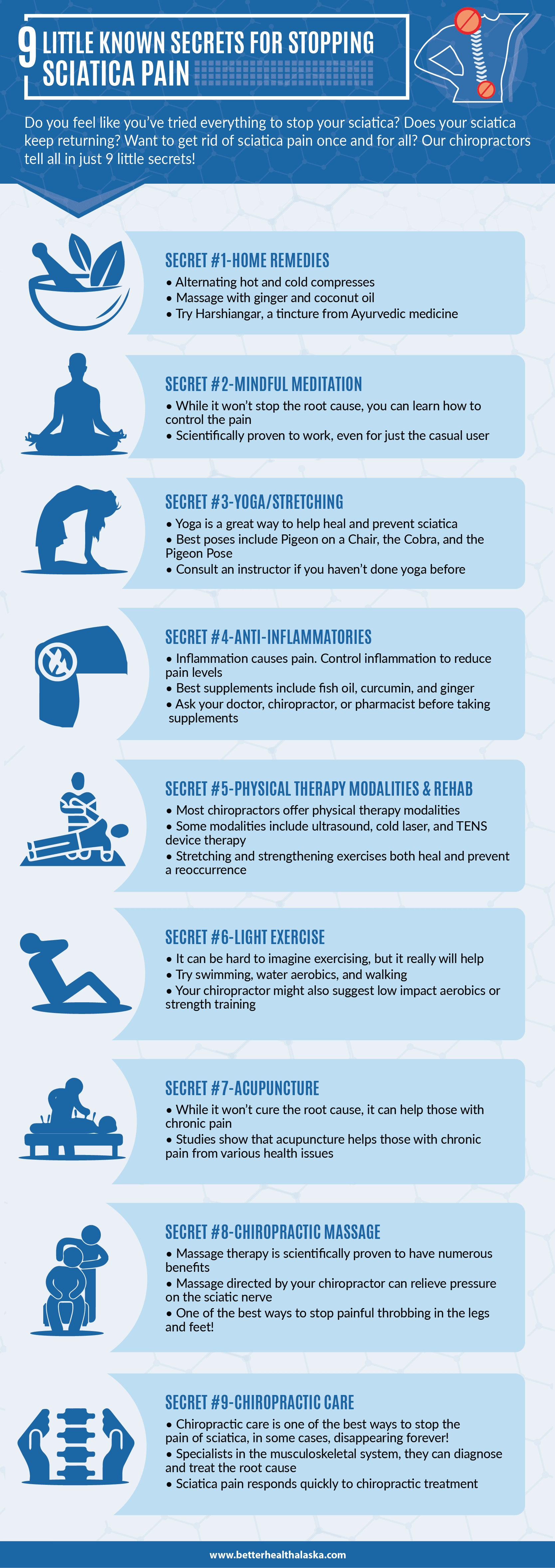Yes, weight loss can help alleviate sciatica symptoms by reducing pressure on the sciatic nerve. Weight loss relieves the strain on the lower back and decreases inflammation, leading to pain relief.
Furthermore, shedding excess pounds improves overall mobility and flexibility, aiding in the recovery process from sciatica. By adopting a healthy lifestyle and incorporating regular exercise and a balanced diet, individuals suffering from sciatica can experience significant relief and prevent future episodes.
Prioritizing weight loss can have a positive impact on managing and reducing sciatica symptoms.

Credit: www.everydayhealth.com
Understanding Sciatica
If you’ve ever experienced the debilitating pain of sciatica, you know just how much it can disrupt your daily life. Sciatica is a condition that occurs when the sciatic nerve, which runs from your lower back down to your feet, becomes irritated or compressed. This irritation can cause a variety of symptoms, such as shooting pain, numbness, and weakness, along the path of the nerve.
Causes Of Sciatica
- Herniated or bulging discs in the spine
- Spinal stenosis, which is the narrowing of the spinal canal
- Compression of the nerve due to muscle imbalance or injury
- Spondylolisthesis, a condition where a vertebra slips out of alignment
These causes can put pressure on the sciatic nerve, leading to the development of sciatica symptoms. It’s important to note that each case of sciatica is unique, and the cause may vary from person to person.
Symptoms Of Sciatica
- Sharp or shooting pain that radiates from the lower back down to the buttocks, thigh, and leg
- Numbness or tingling sensation in the affected leg or foot
- Weakness in the leg or foot, making it difficult to walk or stand
- Difficulty controlling bladder or bowel movements (in severe cases)
Sciatica symptoms can vary in intensity, with some individuals experiencing mild discomfort while others may have severe pain that limits their mobility and daily activities. It’s important to recognize the symptoms of sciatica early on to seek appropriate treatment.
Now that we understand the underlying causes and symptoms of sciatica, let’s explore the relationship between weight loss and sciatica in the next section.
The Relationship Between Weight Loss And Sciatica
The relationship between weight loss and sciatica is a topic of interest for many individuals suffering from this painful condition. While sciatica is typically caused by pressure on the sciatic nerve, it is believed that excess weight can exacerbate the symptoms and make them more intense. Therefore, exploring the impact of weight on sciatica and the potential benefits of weight loss is crucial for effective management and relief of this condition.
Impact Of Weight On Sciatica
Excess weight can overload the spine and put extra pressure on the sciatic nerve, leading to increased discomfort and pain. The sciatic nerve runs from the lower back through the hips and down each leg, and any extra weight can aggravate this nerve, causing shooting pain, numbness, and weakness. In addition to directly pressing on the nerve, excessive weight also contributes to inflammation and structural changes in the spine, further contributing to the development and progression of sciatica symptoms.
Research Findings On Weight Loss And Sciatica
Evidence shows a clear correlation between weight loss and reduction in sciatica symptoms. Weight loss helps alleviate the pressure put on the sciatic nerve, leading to decreased pain and improved mobility. A study published in the Journal of the American Medical Association found that overweight individuals who lost just 10% of their body weight experienced a significant reduction in sciatica symptoms. This suggests that even modest weight loss can have a positive impact on sciatica, making it an essential component of the overall treatment plan.
Another research conducted by the National Institutes of Health revealed that weight loss resulting from a combination of exercise and diet modifications significantly reduced both the frequency and intensity of sciatica symptoms. This study emphasized the importance of adopting a healthy lifestyle that includes regular physical activity and a balanced diet in the management of sciatica.
Effective Weight Loss Strategies For Sciatica Relief
Effective weight loss is often recommended as a strategy to alleviate sciatica symptoms. Losing excess weight can reduce pressure on the sciatic nerve, providing relief from pain and discomfort. By engaging in regular physical activity and adopting a balanced diet, individuals can effectively manage their sciatica symptoms through weight loss.
Effective Weight Loss Strategies for Sciatica ReliefHealthy Diet TipsMaintaining a healthy diet is crucial for supporting weight loss and managing sciatica effectively. Focus on consuming nutrient-dense foods that promote overall well-being while aiding in weight reduction. Incorporate plenty of fresh fruits and vegetables, lean proteins, and whole grains into your meals. Limit intake of processed foods, sugary snacks, and high-fat items to support your weight loss journey and alleviate pressure on your sciatic nerves.Exercise and Physical Activity RecommendationsEngaging in regular physical activity is a cornerstone of successful weight loss and sciatica management. Incorporate low-impact exercises such as walking, swimming, and cycling into your routine to promote weight reduction without placing excessive strain on your back and legs. Additionally, yoga and Pilates can help strengthen core muscles and improve flexibility, which are essential for alleviating sciatica symptoms. Remain consistent with your exercise regimen to experience optimal results in weight loss and sciatica relief.| Healthy Diet Tips |
|---|
| Nutrient-dense foods |
| Fresh fruits and vegetables |
| Lean proteins |
| Whole grains |
| Limit processed and sugary foods |

Credit: www.ebay.com
Other Approaches For Sciatica Relief
Weight loss can be an effective approach for relieving sciatica symptoms, as it helps reduce pressure on the sciatic nerve. Shedding excess weight can alleviate pain and discomfort associated with sciatica, improving overall quality of life.
When it comes to finding relief from sciatica, weight loss is just one piece of the puzzle. While shedding excess pounds can certainly alleviate the pressure on the sciatic nerve, there are other approaches that can provide additional relief. In this article, we will explore two other key methods – physical therapy and medication and pain management – that can effectively reduce sciatica symptoms and improve overall quality of life.Physical Therapy
Physical therapy plays a crucial role in managing sciatica pain. Through a customized exercise program, a physical therapist can help you strengthen the muscles that support your spine, as well as improve your flexibility and range of motion. These exercises are designed to target the root cause of your sciatica, whether it is a herniated disc, spinal stenosis, or other conditions.Additionally, physical therapy can teach you proper body mechanics, such as proper lifting techniques and posture correction. By practicing these techniques, you can minimize the strain on your back and reduce the risk of future sciatica flare-ups.Here are some key benefits of physical therapy for sciatica relief: – Reduction in pain and inflammation. – Improved flexibility and range of motion. – Strengthening of core muscles for better spinal support. – Enhanced endurance and overall physical fitness.Medication And Pain Management
When it comes to managing sciatica pain, medication can play an important role in providing temporary relief. Non-steroidal anti-inflammatory drugs (NSAIDs), such as ibuprofen, can help reduce inflammation and alleviate pain. Muscle relaxants may also be prescribed to relieve muscle spasms and reduce discomfort.In addition to medication, pain management techniques can provide long-lasting relief from sciatica symptoms. These may include: – Epidural steroid injections: This procedure involves injecting corticosteroids directly into the affected area to reduce inflammation and alleviate pain. – Transcutaneous electrical nerve stimulation (TENS): TENS units deliver low-voltage electrical currents to the affected area, stimulating the nerves and providing temporary pain relief. – Heat and cold therapy: Applying heat or cold to the affected area can help reduce inflammation and provide temporary pain relief. – Acupuncture: This traditional Chinese healing technique involves inserting thin needles into specific points on the body to promote natural pain relief.Remember, while medication and pain management techniques can offer relief, they should always be used in conjunction with other approaches, such as weight loss and physical therapy, for optimal results. Consulting with a healthcare professional is essential to determine the most appropriate treatment plan for your specific case of sciatica.Lifestyle Changes For Long-term Sciatica Management
For individuals living with sciatica, making certain lifestyle changes can play a significant role in managing symptoms in the long run. In addition to medical treatment and exercise, implementing ergonomic adjustments and stress management techniques can contribute to alleviating discomfort and promoting overall well-being.
Ergonomic Adjustments
An important aspect of managing sciatica involves making ergonomic adjustments to minimize strain on the affected areas of the body. Consider the following changes:
- Ensure that your work area, whether it’s a desk or a workstation, is properly set up for optimal support and comfort.
- Invest in an ergonomic chair that offers good lumbar support and encourages proper posture.
- Use a cushion or a support pillow to maintain the natural curve of your lower back while sitting for extended periods.
- Position your computer monitor at eye level to avoid straining your neck and upper back.
- Take regular breaks to stretch and walk around, allowing your body to release tension and improve circulation.
- When lifting heavy objects, remember to bend at the knees and use your leg muscles instead of relying on your back, reducing the risk of aggravating your sciatic nerve.
Stress Management Techniques
Stress can worsen sciatica symptoms by increasing muscle tension and inflammation. Therefore, incorporating stress management techniques into your daily routine can be beneficial. Consider the following strategies:
- Practice deep breathing exercises or meditation to promote relaxation and reduce stress levels.
- Engage in regular physical activity, such as walking or swimming, which not only helps release endorphins but also plays a role in stress reduction.
- Allocate time for activities that bring you joy and help you unwind, such as reading a book, engaging in a hobby, or spending quality time with loved ones.
- Establish a regular sleep routine to ensure you get enough rest each night, as lack of sleep can contribute to increased stress levels.
- Consider seeking professional help if stress becomes overwhelming or unmanageable, as therapy or counseling can provide valuable support and coping mechanisms.
By implementing these ergonomic adjustments and stress management techniques, you can create an environment that fosters sciatica relief and enhances your overall well-being. Remember, making these lifestyle changes alongside appropriate medical treatment and exercise can significantly contribute to long-term sciatica management.

Credit: betterhealthalaska.com
Frequently Asked Questions Of Does Weight Loss Help Sciatica
Can Weight Loss Help Relieve Sciatica Pain?
Losing weight can reduce pressure on the sciatic nerve and decrease pain. Excess weight puts stress on the spine and increases inflammation, worsening sciatica symptoms. By adopting a healthier lifestyle, including regular exercise and a balanced diet, weight loss can potentially improve sciatica symptoms.
How Does Weight Loss Affect Sciatica?
Weight loss can alleviate sciatica symptoms by reducing pressure on the sciatic nerve. Shedding excess weight decreases inflammation and relieves stress on the spine, which can improve the overall condition. Losing weight through targeted exercise and healthy eating habits is beneficial for individuals with sciatica.
Can Weight Loss Cure Sciatica?
Weight loss alone cannot cure sciatica, but it can significantly improve its symptoms. By reducing pressure on the sciatic nerve and relieving inflammation, losing weight can contribute to pain relief and improved mobility. However, it is important to consult with a healthcare professional for a comprehensive treatment plan.
Conclusion
Weight loss can alleviate sciatica by reducing pressure on the nerves. However, it’s crucial to combine weight loss with exercise and proper posture for optimal results. By making lifestyle changes and seeking professional advice, individuals can effectively manage their sciatica symptoms and improve their overall well-being.

